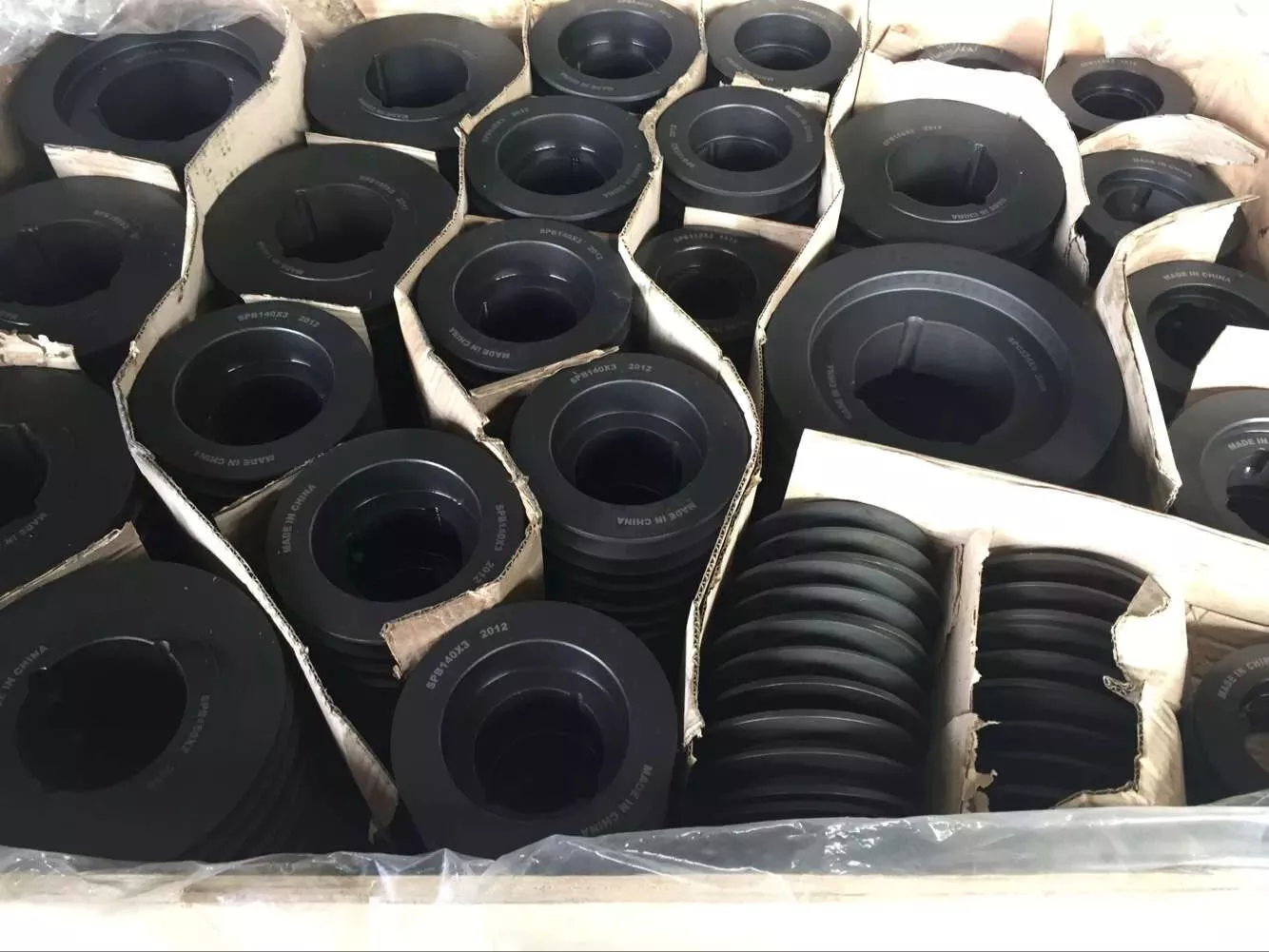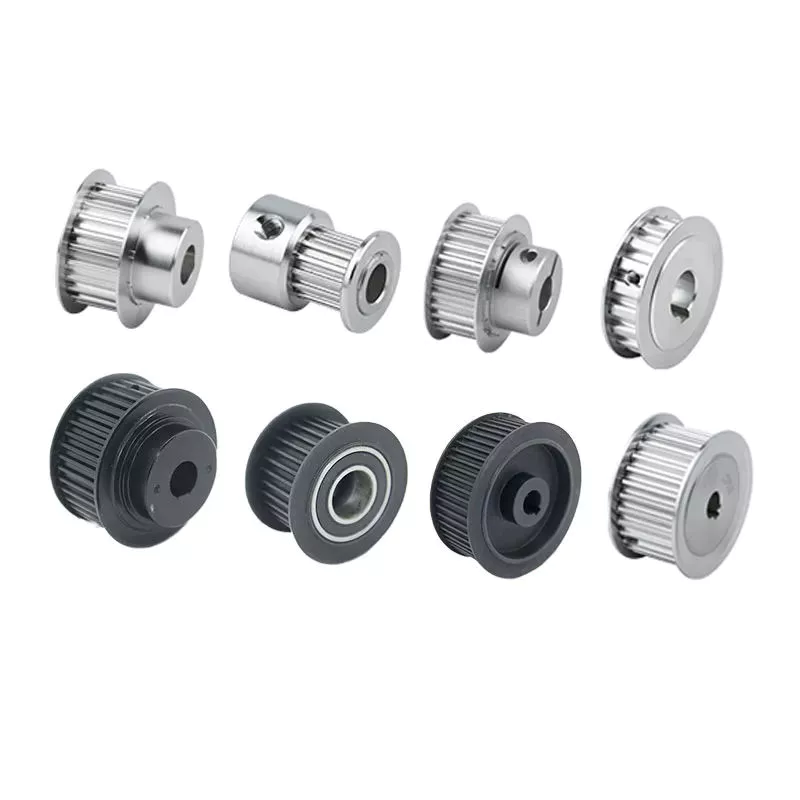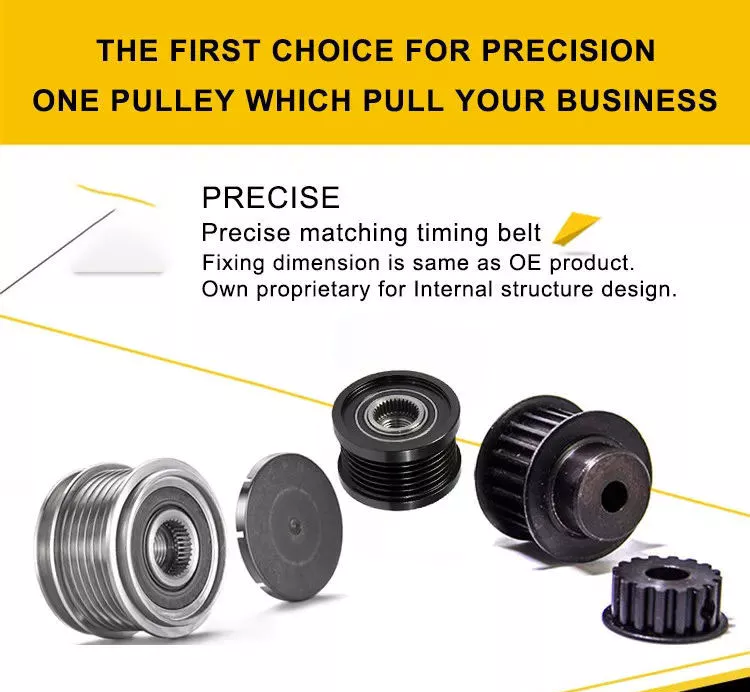Productomschrijving
Productomschrijving
Gietijzeren V-riempoelie Gietijzer met conische boring
Dankzij meer dan 15 jaar ervaring, uiterst nauwkeurige apparatuur en een strikt managementsysteem kan CIMO u V-snaarpoelies leveren met een stabiele kwaliteit en de beste service.
Cast Iron V Belt Pulley,V pulley, v belt pulley, v groove pulley, v groove belt pulley, taper lock pulley, taper lock v belt pulley, taper lock bushing pulley, taper lock pulleys / taper bore pulley, large v belt pulley, double v belt pulley, cast iron v belt pulley belt pulley, variable speed v belt pulleys, v belt pulley split pulley, cast iron v belt pulley
Specificaties V-snaarpoelie:
1) European standard:
A) V-belt pulleys for taper bushings: SPZ, SPA, SPB, SPC; Up to 10 grooves
B) Adjustable speed V-belt pulleys and variable speed pulleys
C) Flat belt pulleys and conveyor belt pulleys
2) American standard:
A) Sheaves for taper bushings: 3V, 5V, 8V
B) Sheaves for QD bushings: 3V, 5V, 8V
C) Sheaves for split taper bushings: 3V, 5V, 8V
D) Sheaves for 3L, 4L or A, and 5L or B belts: AK, AKH, 2AK, 2AKH, BK, BKH, 2BK, 2BKH, 3BK
E) Adjustable sheaves: Poly V-pulley, multi-pitch H, L, J, K and M
3) Bore: Pilot bore, finished bore, taper bore, bore for QD bushing
4) Surface finish: Paint, phosphating, zinc plated
5) Material: Cast iron, ductile iron, nylon, aluminum
6) Made according to drawings and/or samples, OEM inquiries welcomed
| SPA56 | SPB56 | SPC56 | SPZ56 | 1008 |
| SPA63 | SPB63 | SPC63 | SPZ63 | 1108 |
| SPA67 | SPB67 | SPC67 | SPZ67 | 1210 |
| SPA71 | SPB71 | SPC71 | SPZ71 | 1215 |
| SPA75 | SPB75 | SPC75 | SPZ75 | 1310 |
| SPA80 | SPB80 | SPC80 | SPZ80 | 1610 |
| SPA85 | SPB85 | SPC85 | SPZ85 | 1615 |
| SPA90 | SPB90 | SPC90 | SPZ90 | 2012 |
| SPA95 | SPB95 | SPC95 | SPZ95 | 2017 |
| SPA100 | SPB100 | SPC100 | SPZ100 | 2517 |
| SPA106 | SPB106 | SPC106 | SPZ106 | 2525 |
| SPA112 | SPB112 | SPC112 | SPZ112 | 3571 |
| SPA118 | SPB118 | SPC118 | SPZ118 | 3030 |
| SPA125 | SPB125 | SPC125 | SPZ125 | 3525 |
| SPA132 | SPB132 | SPC132 | SPZ132 | 3535 |
| SPA140 | SPB140 | SPC140 | SPZ140 | 4030 |
| SPA150 | SPB150 | SPC150 | SPZ150 | 4040 |
| SPA160 | SPB160 | SPC160 | SPZ160 | 4535 |
| SPA170 | SPB170 | SPC170 | SPZ170 | 4545 |
| SPA180 | SPB180 | SPC180 | SPZ180 | 5040 |
| SPA190 | SPB190 | SPC190 | SPZ190 | 5050 |
| SPA200 | SPB200 | SPC200 | SPZ200 | 6050 |
| SPA212 | SPB212 | SPC212 | SPZ212 | |
| SPA224 | SPB224 | SPC224 | SPZ224 | |
| SPA236 | SPB236 | SPC236 | SPZ236 | |
| SPA250 | SPB250 | SPC250 | SPZ250 | |
| SPA265 | SPB265 | SPC265 | SPZ265 | |
| SPA280 | SPB280 | SPC280 | SPZ280 | |
| SPA300 | SPB300 | SPC300 | SPZ300 | |
| SPA315 | SPB315 | SPC315 | SPZ315 | |
| SPA335 | SPB335 | SPC335 | SPZ335 | |
| SPA355 | SPB355 | SPC355 | SPZ355 | |
| SPA400 | SPB400 | SPC400 | SPZ400 | |
| SPA450 | SPB450 | SPC450 | SPZ450 | |
| SPA500 | SPB500 | SPC500 | SPZ500 | |
| SPA560 | SPB560 | SPC560 | SPZ560 | |
| SPA630 | SPB630 | SPC630 | SPZ630 | |
| SPA710 | SPB710 | SPC710 | SPZ710 | |
| SPA800 | SPB800 | SPC800 | SPZ800 | |
| SPA900 | SPB900 | SPC900 | SPZ900 | |
| SPA1000 | SPB1000 | SPC1000 | SPZ1000 |
Gedetailleerde foto's
SPC560-10-5050
SPB1000-4-4040
Grote voorraad in magazijn
Werkplaats
Verpakking en verzending
Export houten doos
Veelgestelde vragen
V1: Bent u een handelsonderneming of een fabrikant?
A: Wij zijn een fabriek.
V2: Hoe lang duurt de levertijd en verzending?
1. Doorlooptijd monster: 10-20 dagen
2. Productiedoorlooptijden: 30-45 dagen na bevestiging van de bestelling.
V3: Wat zijn uw voordelen?
1. De meest concurrerende prijs en goede kwaliteit.
2. Perfecte technische ingenieurs bieden u de beste ondersteuning.
3. OEM is beschikbaar.
/* March 10, 2571 17:59:20 */!function(){function s(e,r){var a,o={};try{e&&e.split(“,”).forEach(function(e,t){e&&(a=e.match(/(.*?):(.*)$/))&&1
| Certificering: | ISO |
|---|---|
| Katrolmaten: | Type A |
| Productieproces: | Gieten |
| Materiaal: | Ijzer |
| Oppervlaktebehandeling: | Gefosfateerd |
| Sollicitatie: | Chemische industrie, graantransport, mijnbouwtransport, elektriciteitscentrale |
| Aanpassing: |
Beschikbaar
| Aangepast verzoek |
|---|

How do pulleys function in various types of vehicles and machinery?
Pulleys play crucial roles in numerous types of vehicles and machinery, enabling the transmission of power, control of mechanical systems, and efficient operation. Here's how pulleys function in various applications:
1. Automotive Engines: In vehicles, pulleys are commonly used in the engine's accessory drive system. The crankshaft pulley, also known as the harmonic balancer, is connected to the engine's crankshaft and drives various accessories such as the alternator, power steering pump, and air conditioning compressor. The pulleys enable the transfer of rotational power from the engine to these accessories, allowing them to perform their respective functions.
2. Belt-Driven Systems: Pulleys are extensively used in belt-driven systems across various machinery and equipment. These systems utilize belts, such as V-belts or timing belts, which wrap around pulleys to transfer power. Examples include conveyor systems, industrial machinery, agricultural equipment, and HVAC systems. The pulleys provide the necessary grip and tension to ensure efficient power transmission and drive system operation.
3. Cranes and Hoists: Pulleys are integral components of cranes and hoists, enabling the lifting and movement of heavy loads. Multiple pulleys, often arranged in a block and tackle configuration, are used to create mechanical advantage, reducing the effort required to lift the load. By distributing the load's weight over multiple strands of rope or cable, pulleys allow for controlled lifting and precise positioning of objects.
4. Construction Equipment: Pulleys are found in various types of construction machinery. For example, in excavators and cranes, pulleys are used in the wire rope systems for lifting and lowering the boom, bucket, or other attachments. Pulleys help in managing the forces involved in these operations, providing smooth and controlled movement.
5. Elevators: Pulleys are essential components in elevator systems. Elevator cars are suspended by steel cables that run over pulleys. These pulleys are connected to an electric motor through a system of gears and sheaves. As the motor rotates the pulleys, the elevator car moves up or down. Pulleys in elevator systems help in efficiently transferring power and maintaining the stability and safety of vertical transportation.
6. Exercise Equipment: Pulleys are widely used in exercise machines and gym equipment to provide resistance and enable adjustable resistance levels. By incorporating pulley systems with different configurations and cable arrangements, exercise equipment can offer a variety of exercises targeting specific muscle groups.
7. Marine Applications: Pulleys are utilized in various marine applications, such as sailboats and winches. Pulleys help in controlling the movement and tension of ropes and cables, enabling sail adjustments, mast raising and lowering, and other rigging operations.
8. Garage Doors: Pulleys are employed in garage door mechanisms to facilitate the smooth opening and closing of the doors. They are used in conjunction with cables or belts, allowing for the transfer of force from the door opener to the door itself.
These examples demonstrate the versatility and importance of pulleys in a wide range of vehicles and machinery. By utilizing pulleys, these systems can achieve efficient power transmission, mechanical advantage, controlled movement, and improved functionality.

Kunnen katrollen worden gebruikt in landbouwmachines en -apparatuur?
Ja, katrollen kunnen worden gebruikt in landbouwmachines en -apparatuur om verschillende taken te vergemakkelijken en de efficiëntie te verbeteren. Het zijn veelzijdige componenten die mechanische voordelen bieden, krachtoverbrenging mogelijk maken en helpen bij de beweging en controle van landbouwwerktuigen. Dit is hoe katrollen kunnen worden gebruikt in landbouwtoepassingen:
1. Riemaandrijvingen: Poelies worden vaak gebruikt in riemaangedreven systemen in landbouwmachines. Ze worden gebruikt in combinatie met riemen om vermogen over te brengen van de motor naar verschillende componenten, zoals pompen, ventilatoren en snijmechanismen. Door de grootte en opstelling van de poelies aan te passen, kunnen boeren de snelheid en het koppel van de aangedreven apparatuur regelen en de prestaties ervan optimaliseren voor specifieke taken.
2. Oogstapparatuur: Katrollen worden gebruikt in verschillende soorten oogstapparatuur, zoals maaidorsers, hakselaars en balenpersen. Ze worden gebruikt in de snij- en dorsmechanismen om kracht over te brengen en de roterende componenten aan te drijven. Katrollen maken de synchronisatie van verschillende onderdelen mogelijk, wat zorgt voor een efficiënte oogst en verwerking van gewassen.
3. Irrigatiesystemen: Katrollen spelen een rol in landbouwirrigatiesystemen, met name bij de werking van waterpompen. Ze zijn opgenomen in de pompaandrijfsystemen en helpen bij het overbrengen van vermogen van motoren naar de pompwaaiers. Door katrollen te gebruiken, kunnen boeren de pompsnelheid en het debiet aanpassen om te voldoen aan de irrigatievereisten van verschillende gewassen en bodemomstandigheden.
4. Hooi- en voedermachines: In hooi- en voedermachines worden katrollen gebruikt om verschillende componenten aan te drijven, zoals snijbladen, conditioneringsrollen en toevoermechanismen. Ze maken de overdracht van vermogen van de tractor of motor naar deze componenten mogelijk, wat efficiënt snijden, verwerken en voeren van hooi- en voedermaterialen mogelijk maakt.
5. Conveyor Systems: Pulleys are employed in conveyor systems used in agriculture for material handling tasks. They help drive the belts or chains that transport crops, grains, or other agricultural products. Pulleys ensure smooth and controlled movement, enabling the efficient transfer of materials between different stages of processing, storage, or transport.
6. Veehouderijapparatuur: Katrollen worden gebruikt in veehouderijapparatuur, zoals voermengwagens, melkmachines en ventilatiesystemen. Ze worden gebruikt om vermogen over te brengen en de beweging van verschillende componenten die bij deze systemen betrokken zijn, te vergemakkelijken. Katrollen dragen bij aan de soepele werking en automatisering van veehouderijprocessen, waardoor de productiviteit en het dierenwelzijn worden verbeterd.
7. Aanpassingen van apparatuur: Katrollen worden ook gebruikt in landbouwapparatuur om aanpasbaarheid en flexibiliteit te bieden. Ze maken het mogelijk om de maaihoogte, riemspanning en machine-instellingen aan te passen, waardoor boeren de apparatuur kunnen aanpassen aan verschillende gewassen, veldomstandigheden of operationele vereisten.
Over het algemeen spelen katrollen een belangrijke rol in landbouwmachines en -apparatuur, ze verbeteren de krachtoverbrenging, maken nauwkeurige controle mogelijk en verbeteren de algehele efficiëntie van landbouwactiviteiten. Hun veelzijdigheid en aanpasbaarheid maken ze waardevolle componenten in verschillende landbouwtoepassingen.

What is a pulley, and how does it function in mechanical systems?
A pulley is a simple machine consisting of a grooved wheel and a rope, cable, or belt that runs along the groove. It is used to transmit force and motion in mechanical systems. Here's a detailed explanation of how a pulley functions:
1. Mechanical Advantage: The primary function of a pulley is to provide mechanical advantage. By changing the direction of the force applied and distributing it over multiple segments of the rope or belt, a pulley system allows for easier lifting or moving of heavy loads. The mechanical advantage gained depends on the number of pulleys used in the system.
2. Force Transmission: When a force is applied to one end of the rope or belt, it creates tension that causes the pulley to rotate. As the pulley turns, the force is transmitted to the load attached to the other end of the rope or belt. This force transmission allows for the movement and manipulation of objects in mechanical systems.
3. Directional Change: One of the key functions of a pulley is to change the direction of the applied force. By redirecting the force along a different path, a pulley system enables the operator to exert force from a more convenient or advantageous position. This directional change is particularly useful in situations where the force needs to be applied vertically, horizontally, or at an angle.
4. Speed and Torque Conversion: In addition to changing the direction of force, pulleys can also be used to convert speed and torque in mechanical systems. By varying the size of the pulleys or using pulleys of different diameters, the rotational speed and torque can be adjusted according to the requirements of the system. This speed and torque conversion allows for the optimization of power transmission and the matching of different rotational speeds between input and output components.
5. Multiple Pulley Systems: Pulleys can be combined in systems to achieve increased mechanical advantage or to create complex motion patterns. In systems with multiple pulleys, such as block and tackle arrangements, the load is distributed over several segments of rope or belt, further reducing the effort required to lift heavy objects. These systems are often used in cranes, elevators, and other applications where heavy lifting is necessary.
6. Fixed and Movable Pulleys: Pulleys can be categorized as fixed or movable. A fixed pulley is attached to a stationary structure, and its main function is to change the direction of force. A movable pulley, on the other hand, is attached to the load being moved and moves with it. Movable pulleys provide mechanical advantage by reducing the effort required to lift the load.
7. Belt and Rope Pulleys: Pulleys can have different designs depending on the application. Belt pulleys typically have a grooved surface to grip and guide belts, while rope pulleys have a smooth surface to minimize friction and prevent rope wear. The choice between belt and rope pulleys depends on factors such as load requirements, operational environment, and desired efficiency.
Overall, a pulley is a versatile mechanical device that functions as a force multiplier, directional changer, and speed/torque converter in mechanical systems. Its ability to provide mechanical advantage, change force direction, and facilitate complex motion patterns makes it an essential component in various applications, including lifting, transportation, and power transmission.


redacteur door CX
2024-01-09
